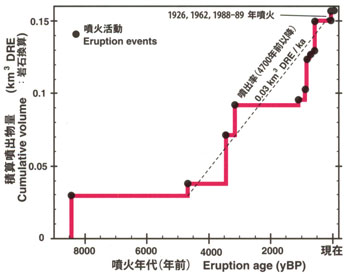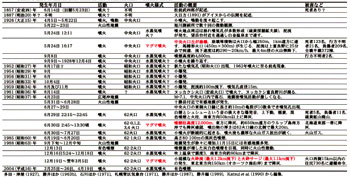Tokachidake Volcano
1: Introduction / 2: Overview of the Tokachidake Volcano Group
3: Eruptive history of the Tokachidake Volcano Group
4: Eruptions in historical times
5: Petrological features of erupted rocks - 6: Sulfur deposit and hot springs
7: Observation of volcanic activities - 8: Points to be noted for mitigation of volcanic disaster
Acknowledgements / References
![]() PREV
PREV ![]() NEXT
NEXT
7: Observation of volcanic activities - 8: Points to be noted for mitigation of volcanic disaster
7: Observation of volcanic activities
Full-time observation of seismicity for the Tokachidake Volcano Group began in January 1959, and Tokachidake Volcano Observatory belonged to Japan Meteorological Agency ( JMA ) was opened at the Shirogane Hot Spring after a year of the 1962 eruption. In recent years many organizations set up various observation facilities at many locations. At present most observation points are concentrated in the northwestern slope of Tokachi Dake and around the Nukkakushi crater ( Ansei crater ). Thirteen seismographs are set up by JMA, Hokkaido University, National Research Institute for Disaster Prevention, and Hokkaido Administrative Office, while four air shock monitors by JMA, Hokkaido University, and Hokkaido Administrative Office as at December 2009. Six GPS are set up by JMA, Geographical Survey Institute, and Geological Survey of Hokkaido. Also JMA, Hokkaido Regional Development Bureau and Hokkaido Administrative Office set up distance surveillance cameras. In December 2007 JMA introduced eruption warning system consisting of five levels ( 1 to 5 ) with constant monitoring of volcanic activities, and the warning level is publicized. Tokachidake Volcano Observatory has become unmanned since 1955, and the data are automatically transferred to Sapporo District Meteorological Observatory.
8: Points to be noted for mitigation of volcanic disaster
The characteristics of eruptions of the Tokachidake Volcano Group in Holocene are cyclical occurrences of pyroclastic falls by Strombolian to sub-Plinian eruptions followed by extrusion of lavas. Most activities are comparatively quiet. Pyroclastic flow that could be disastrous is known in one occasion accompanied with the activity at the Ground crater in 4.7 ka to 3.3 ka. The amount ejected in each eruption is small and the total volume of ejecta in 4,700 years is estimated to be about 0.13 km3 DRE ( ![]() Fig.7 ). This is smaller as compared with other active volcanoes in Hokkaido. There seems to be little changes in the rates of magmatic effusion in the last 4,700 years. This may suggest that similar type of activities is expected to continue for the foreseeable future. On the other hand, at the Nukkakushi crater ( Ansei crater ) no extrusion of magma in Holocene is recognized, but small-scale phreatic explosions occurred repeatedly. Therefore not only magmatic eruptions in the northwestern slope of Tokachi Dake, but also hydrothermal activities and related phreatic explosions at the Nukkakushi crater ( Ansei crater ) should carefully be monitored. Relationship between hydrothermal and magmatic activities needs to be examined in the future.
Fig.7 ). This is smaller as compared with other active volcanoes in Hokkaido. There seems to be little changes in the rates of magmatic effusion in the last 4,700 years. This may suggest that similar type of activities is expected to continue for the foreseeable future. On the other hand, at the Nukkakushi crater ( Ansei crater ) no extrusion of magma in Holocene is recognized, but small-scale phreatic explosions occurred repeatedly. Therefore not only magmatic eruptions in the northwestern slope of Tokachi Dake, but also hydrothermal activities and related phreatic explosions at the Nukkakushi crater ( Ansei crater ) should carefully be monitored. Relationship between hydrothermal and magmatic activities needs to be examined in the future.
Points to be remembered to mitigate volcanic disaster for the Tokachidake Volcano Group include possibilities of outburst of hydrothermal water and collapse of the mountain around the Ground crater and the Nukkakushi crater ( Ansei crater ) as hydrothermal alterations of rocks constituting the mountains are in advanced state even if magma extrusion itself is small in scale. Also the following would be a big problem: the occurrence of volcanic mudflow caused by melting snow because of prolonged period of snow and accumulated large amount of snow in the volcano group. During the 1926 eruption a large-scale mudflow occurred under the combined effect of cone collapse, spurting of high temperature water, and melting of snow. It would be considered that similar mudflows had repeated during last 4,700 years. Occurrences of seven large-scale mudflows were identified in the catchment of the Furano River in Holocene ( Nanri et al., 2008 ). The dates of some of the mudflows recognized in the field are not related to the dates of the eruptions described in this map. It is possible that those might have occurred related to large earthquakes but not to eruptions. Therefore, not only accurate recognitions of precursors of the eruptions through observation of the volcanoes, but also routine preparation measures for the mitigation of disaster is utmost important.
For three magmatic eruptions which occurred during 20th century, precursors such as increase of sublimating sulfur, rising of water temperature at hot spring, repetition of small-scale phreatic explosions, and increase of number of earthquakes have been recorded ( ![]() Table1 ). Durations of eruptions were a month to two years culminating within several hours to several days from the commencement of the eruptions. Those past cases would be useful for preparations of observation systems and explanations of observed results. However, eruptive history in Holocene suggests that preparations against lava extrusion should be included.
Table1 ). Durations of eruptions were a month to two years culminating within several hours to several days from the commencement of the eruptions. Those past cases would be useful for preparations of observation systems and explanations of observed results. However, eruptive history in Holocene suggests that preparations against lava extrusion should be included.

